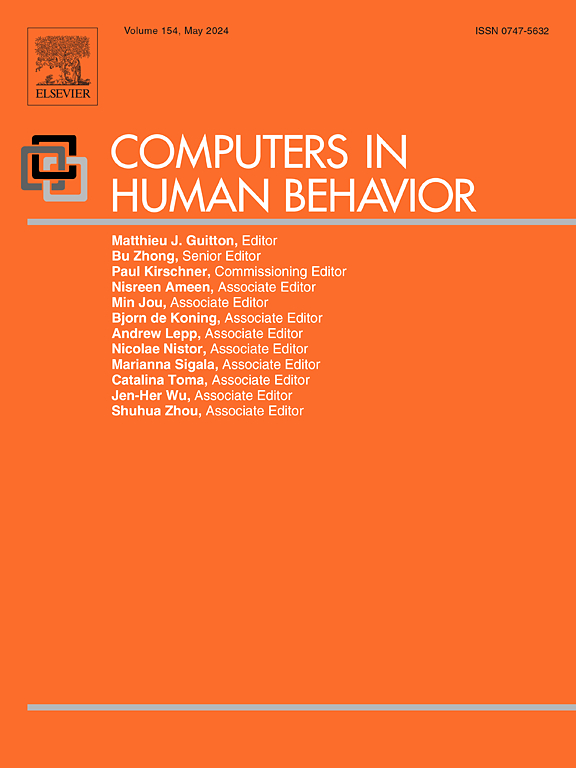从出生到青春期自我调节和数字娱乐的荟萃分析
IF 9
1区 心理学
Q1 PSYCHOLOGY, EXPERIMENTAL
引用次数: 0
摘要
我们有充分的理由认为,自我调节与我们的数字娱乐时间、选择和行为有关。然而,其关联的方向、程度和多样性尚不明确。为了给这一公众高度关注的问题提供更有力、更细致的证据,本研究对从出生到青春期的自我调节与数字娱乐之间的关联进行了全面的荟萃分析--整合了来自 234,476 名儿童和青少年的 183 项研究,报告了 232 种关联。在这些研究中,数字娱乐主要集中在屏幕时间的调查、有问题的数字参与的特征、接触暴力内容、与陌生人在线交流、sexting 和媒体多任务处理。虽然在自我调节和数字娱乐的各个方面之间观察到了负的双变量关联模式,但屏幕时间的关联强度较弱(使用电脑的关联度为-.04,使用社交媒体的关联度为-.15)。一旦考虑了控制变量,与接触暴力数字内容之间的关系也变得同样微不足道,这表明其他变量很可能是这些相关性的原因。这降低了我们对这些关联的信心。相比之下,较低的自我调节能力与问题参与(问题游戏的相关系数为-.28,问题手机使用的相关系数为-.41)、与陌生人在线交流(相关系数为-.18)和性短讯(相关系数为-.20)的相关性更高。这种结果模式表明,不同类型的数字活动之间存在着不同的关系,在我们的元分析中,这种关系从无效到强烈和负面不等。鉴于将自我调节或数字娱乐定位为预测因素的纵向研究仍存在关联,这种关系可能是双向的。虽然自我调节与游戏时间的负相关随着参与者年龄的增加而越来越强,但这些关联的大多数调节因素并不显著。这项研究有助于厘清自我调节与人生早期阶段的数字选择和行为之间的关系。本文章由计算机程序翻译,如有差异,请以英文原文为准。
A meta-analysis of self-regulation and digital recreation from birth to adolescence
There is good reason to implicate self-regulation in our digital recreation duration, choices, and behaviours. However, the direction, degree, and diversity of their association is unclear. To offer more robust and nuanced evidence to this issue of acute public concern, the current study presents a comprehensive meta-analysis of the associations between self-regulation and digital recreation from birth to adolescence – consolidating 183 studies reporting 232 associations from 234,476 children and adolescents. Across these studies, digital recreation clustered into investigations of screen time, features of problematic digital engagement, exposure to violent content, communicating with strangers online, sexting, and media multitasking. Although a pattern of negative bivariate associations was observed between self-regulation and aspects of digital recreation, the strength of association for screen time was weak (r = −.04 for computer use to r = −.15 for social media use). Once control variables were considered, relationships with exposure to violent digital content were rendered similarly trivial, suggesting other variables likely account for these correlations. This reduces our confidence in these associations. In contrast, lower self-regulation was more highly associated with problematic engagement (r = −.28 for problematic gaming to r = −.41 for problematic mobile phone use), communicating with strangers online (r = −.18), and sexting (r = −.20). This pattern of results points to a relationship that is variable by type of digital activity, which in our meta-analyses ranged from null to strong and negative. Where a relationship exists, it may be bi-directional given associations remained for longitudinal studies that positioned either self-regulation or digital recreation as predictor. Most moderators of these associations were non-significant, although the negative association of self-regulation with time spent gaming was increasingly strong with increasing participant age. This study instigates a disentangling of the nature of the relationship between self-regulation and digital choices and behaviours across the early stages of life.
求助全文
通过发布文献求助,成功后即可免费获取论文全文。
去求助
来源期刊

Computers in Human Behavior
Multiple-
CiteScore
19.10
自引率
4.00%
发文量
381
审稿时长
40 days
期刊介绍:
Computers in Human Behavior is a scholarly journal that explores the psychological aspects of computer use. It covers original theoretical works, research reports, literature reviews, and software and book reviews. The journal examines both the use of computers in psychology, psychiatry, and related fields, and the psychological impact of computer use on individuals, groups, and society. Articles discuss topics such as professional practice, training, research, human development, learning, cognition, personality, and social interactions. It focuses on human interactions with computers, considering the computer as a medium through which human behaviors are shaped and expressed. Professionals interested in the psychological aspects of computer use will find this journal valuable, even with limited knowledge of computers.
 求助内容:
求助内容: 应助结果提醒方式:
应助结果提醒方式:


